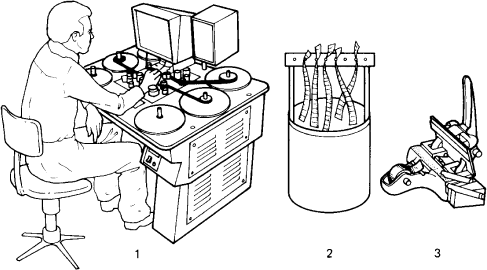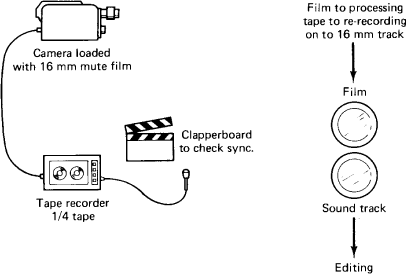Using Film
Digital video cameras have brought mobility and flexibility in the highly competitive world of television news, but there still remains pockets of film craft where speed is not a priority. Documentary makers will always experiment with digital cameras and digital sound acquisition, but many maintain a tradition of shooting longer form documentary on 35 mm film, which is preferred for its picture quality and the precision of manual editing. Some picture editors say that the physical handling of the film enhances their creative instincts in a way electronic or digital editing does not. Television news reporters are only likely to see real film if it comes from an archive, and to use that in part of a report it would have to be transferred into a modern format for editing.
Film technique
Before the lightweight video revolution of the late 1970s, the manufacturers of newsfilm had introduced a 16 mm cine equivalent of the amateur photographer’s 35 mm colour transparency, an original positive for projection but without the need to print. Documentary makers, however, have tended to stick to the more conventional negative–positive process in which the first viewing is made from a print of the rushes–unedited raw material–and the original is stored under laboratory conditions to keep it free from dust, scratches or accidental mishandling during editing. Only after the rushes have been assembled, first into a rough cut and then into a final fine cut, is the original negative produced and edited exactly to match.
Sound
The most commonly used sound system in documentary filming is known as double system (otherwise separate magnetic) or synchronous sound (sync sound). Here the camera operator takes the pictures while the recordist captures the sound on a high-quality recorder using quarter-inch magnetic tape. Camera and recorder work separately but are linked electronically to maintain synchronism. In operation the start of each shot is indicated by use of a clapperboard, although sometimes it is more convenient to make the mark with an inverted ‘end board’. Once filming is complete, the film is developed separately and the quarter-inch tape re-recorded onto a ferrous oxide surface.
Using video with film
Although they might have a preference for film, producers and directors often make practical use of electronic technology. Rushes are easily transferred to home video format for examination and review at leisure. In this way preliminary decisions about the shape and content can be made without wasting valuable operational resources. ‘Off-line’ editing, an intermediate assembly of the video sound and pictures, may also take place at this point, providing the picture editor with an accurate guide from which the original negative can be cut.
Film sound
Many documentary makers use film in preference to videotape. The double system (also known as sync sound or sepmag) uses a separate tape machine to record the sound synchronously with the film.

Film editing equipment
(1) Editing machine, (2) film bin on which the selected shots are pinned in sequence, and (3) the tape joiner. Cut film is butted together with transparent sticky tape.

